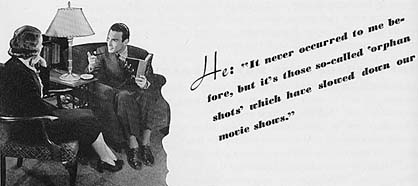
![]()

What's an "orphan film" anyway?
Narrowly defined, it's a motion picture abandoned by its owner or caretaker. More generally, the term refers to all manner of films outside of the commercial mainstream: public domain materials, home movies, outtakes, unreleased films, industrial and educational movies, independent documentaries, ethnographic films, newsreels, censored material, underground works, experimental pieces, silent-era productions, stock footage, found footage, medical films, kinescopes, small- and unusual-gauge films, amateur productions, surveillance footage, test reels, government films, advertisements, sponsored films, student works, and sundry other ephemeral pieces of celluloid (or paper or glass or tape or . . . ).
For examples, visit the National Film Preservation Foundation, an institution dedicated to saving orphan films.
The "Orphans of the Storm" symposium embraces the broader definition of this new rubric in film preservation and seeks to bring together scholars, artists, archivists, collectors, curators, conservators and enthusiasts who recognize the Orphic value of these neglected aspects of our collective visual culture.
Orphans of the Storm (1921) was an epic feature film directed by D. W. Griffith, starring Dorothy and Lillian Gish as two orphaned sisters separated by the storm of the French Revolution. The film was restored by the Museum of Modern Art in 1996 and is now available on VHS from Kino Video. A DVD version of the restored Orphans of the Storm is distributed by Image Entertainment via DVDPlanet.
Orphans of the Storm's source was "Le Deux Orphelines" , a popular 19th-century play by Adolphe d'Ennery and Eugène Cormon. The Two Orphans was made into a motion picture no less than four times before Griffith revised it. A 1908 French film version was the object of a notable copyright infringement case, though the film no longer survives. Neither does the 1910 remake by Kalem. Nor does the 1915 Fox feature starring Theda Bara. However, a nitrate print of The Two Orphans (1911, Selig Polyscope) was discovered by film historian Don Crafton in the hands of a private collector in Milwaukee. The Wisconsin Center for Film and Theater Research and the UCLA Film and Television Archive preserved the film with the help from the American Film Institute. Crafton commented on this version when it was screened at "Orphans I." An excerpt appears in the documentary The Race to Save 100 Years (1997, Turner/Warner Bros.) as an example of nitrate deterioration. The National Film Preservation Foundation and others have used a still image of The Two Orphans as an icon of the need to preserve and restore motion pictures.
As a colloquialism, "orphans of the storm" might refer to any imperiled objects caught in the maelstrom of larger forces. But as a film metaphor, the name has become shorthand for all of the problems of preserving cinema.
Dictionaries suggest at least three connotations of "orphan," each of which points to problems in the survival of films.
orphan 1.
one deprived of protection or advantage (orphans of the storm).
His outtakes, like his mother's home movies, deteriorated because no
archive would store or preserve them.
orphan 2.
an item not developed or marketed because its limited use makes it unprofitable
(an orphan drug).
Charles Burnett's Killer of Sheep became an orphan film for twenty
years because no distributor would pick up this challenging work.
orphan 3.
a discontinued model (an orphan automobile).
The aviatrix recorded some remarkable aerial footage, but she found
herself with a set of orphan films when no lab would develop her 9.5mm
footage.
Gregory Lukow, in his 1999 address to "Orphans of the Storm I," credited David Francis of the Library of Congress with using the term "orphan film" in hearings that led to the National Film Preservation Act of 1992.
Steve Leggett of the National Film Preservation Board has located a use of the term "orphan film" as early as 1992.
Paolo Cherchi-Usai of the George Eastman House suggested the usefulness of the orphan metaphor in his 1999 keynote address, "What is an Orphan Film?"
Elizabeth Farnsworth on PBS's "The New Hour" broadcast a report, "Saving Orphan Films," on January 12, 2001.